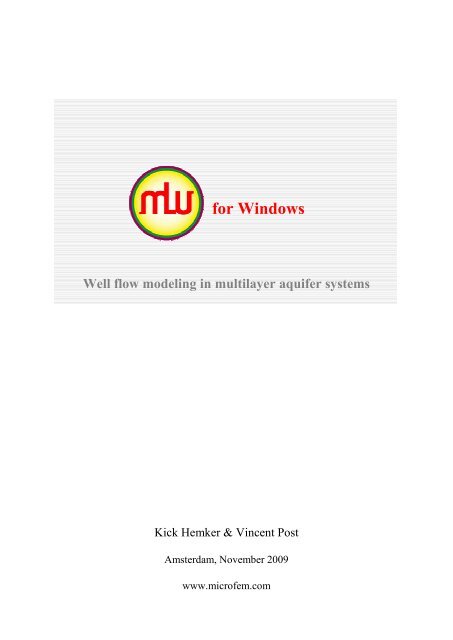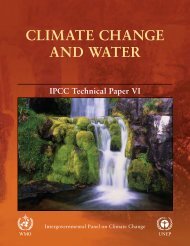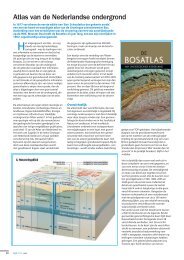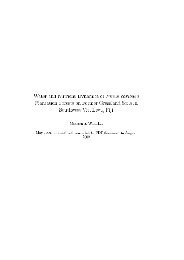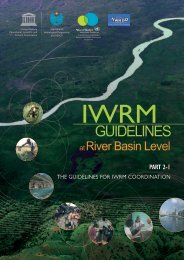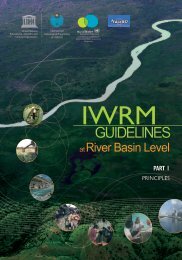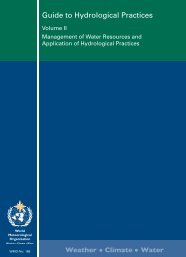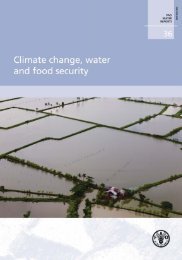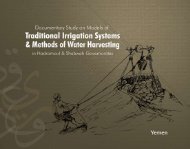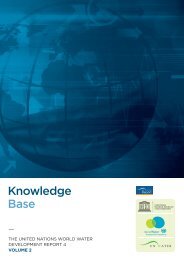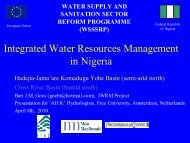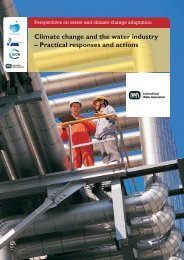MLU for Windows User's Guide ⢠Well flow modelling ... - Hydrology.nl
MLU for Windows User's Guide ⢠Well flow modelling ... - Hydrology.nl
MLU for Windows User's Guide ⢠Well flow modelling ... - Hydrology.nl
You also want an ePaper? Increase the reach of your titles
YUMPU automatically turns print PDFs into web optimized ePapers that Google loves.
<strong>MLU</strong> <strong>for</strong> <strong>Windows</strong><strong>Well</strong> <strong>flow</strong> modeling in multilayer aquifer systems<strong>MLU</strong>Aquifer and Pump Test Analysis SoftwareSlug test analysis and Step drawdown test analysisAnalytical groundwater <strong>flow</strong> <strong>modelling</strong> and pumping test simulationsConfined Aquifer, Unconfined Aquifer, Leaky AquiferKick Hemker & Vincent PostAmsterdam, November 2009www.microfem.com
<strong>MLU</strong> <strong>for</strong> <strong>Windows</strong>CONTENTSIntroduction . . . . . . . . . . . . . . . . . . . . . . . . . . . . . . . . . . . . . . . . . . . . . . . . . . . . . . . 3Solution Method . . . . . . . . . . . . . . . . . . . . . . . . . . . . . . . . . . . . . . . . . . . . . 3Application. . . . . . . . . . . . . . . . . . . . . . . . . . . . . . . . . . . . . . . . . . . . . . . . . . 4<strong>MLU</strong> versus numerical models . . . . . . . . . . . . . . . . . . . . . . . . . . . . . . . . . . 4Software capacity . . . . . . . . . . . . . . . . . . . . . . . . . . . . . . . . . . . . . . . . . . . . 5Data input . . . . . . . . . . . . . . . . . . . . . . . . . . . . . . . . . . . . . . . . . . . . . . . . . . 5Inverse modeling . . . . . . . . . . . . . . . . . . . . . . . . . . . . . . . . . . . . . . . . . . . . 5Data output . . . . . . . . . . . . . . . . . . . . . . . . . . . . . . . . . . . . . . . . . . . . . . . . . 5Graphical output . . . . . . . . . . . . . . . . . . . . . . . . . . . . . . . . . . . . . . . . . . . . . 5Free try-out version . . . . . . . . . . . . . . . . . . . . . . . . . . . . . . . . . . . . . . . . . . . 6Price and orders . . . . . . . . . . . . . . . . . . . . . . . . . . . . . . . . . . . . . . . . . . . . . 6Free updates and User support . . . . . . . . . . . . . . . . . . . . . . . . . . . . . . . . . . 6User instructions . . . . . . . . . . . . . . . . . . . . . . . . . . . . . . . . . . . . . . . . . . . . . . . . . . . 7Installing and running <strong>MLU</strong> . . . . . . . . . . . . . . . . . . . . . . . . . . . . . . . . . . . . 7Data input 1: General info . . . . . . . . . . . . . . . . . . . . . . . . . . . . . . . . . . . . . 8Data input 2: Aquifer system . . . . . . . . . . . . . . . . . . . . . . . . . . . . . . . . . . . 9Data input 3: Pumping wells . . . . . . . . . . . . . . . . . . . . . . . . . . . . . . . . . . . 11Data input 4: Observation wells . . . . . . . . . . . . . . . . . . . . . . . . . . . . . . . . . 13Results: Parameter optimization . . . . . . . . . . . . . . . . . . . . . . . . . . . . . . . . . 14Results: Time graphs . . . . . . . . . . . . . . . . . . . . . . . . . . . . . . . . . . . . . . . . . 17Results: Contour plot . . . . . . . . . . . . . . . . . . . . . . . . . . . . . . . . . . . . . . . . . 19Export: Save curves as FTH . . . . . . . . . . . . . . . . . . . . . . . . . . . . . . . . . . . 20Export: Save contours as XYZ . . . . . . . . . . . . . . . . . . . . . . . . . . . . . . . . . 20Export: Save model as FEM . . . . . . . . . . . . . . . . . . . . . . . . . . . . . . . . . . . 21Verification tests and Example models . . . . . . . . . . . . . . . . . . . . . . . . . . . . . . . . . 22Main characteristics of the example models . . . . . . . . . . . . . . . . . . . . . . . 23Optimization results Example Schroth.mlu . . . . . . . . . . . . . . . . . . . . . . . 26<strong>MLU</strong> data file layout . . . . . . . . . . . . . . . . . . . . . . . . . . . . . . . . . . . . . . . . . . . . . . . 27References . . . . . . . . . . . . . . . . . . . . . . . . . . . . . . . . . . . . . . . . . . . . . . . . . . . . . . 28License agreement . . . . . . . . . . . . . . . . . . . . . . . . . . . . . . . . . . . . . . . . . . . . . . . . . 292
INTRODUCTION<strong>MLU</strong> <strong>for</strong> <strong>Windows</strong> is a groundwater modeling tool to compute drawdowns, analyze well <strong>flow</strong>and aquifer test data, and design well fields. <strong>MLU</strong> <strong>for</strong> <strong>Windows</strong> combines:• An innovative analytical solution technique <strong>for</strong> well <strong>flow</strong> in layered aquifer systems• Stehfest’s numerical method to convert the solution from the Laplace domain into thereal domain• The superposition principle, both in space (multiple wells) and time (variabledischarges)• The Levenberg-Marquardt algorithm <strong>for</strong> parameter optimization (automated curvefitting).This unique combination of techniques allows all tests to be analyzed in a consistent way witha single user interface. Results are printed in ASCII files and plotted as time-drawdowngraphs and animated contour plots.Solution MethodAs a rule present day software <strong>for</strong> aquifer and slug test analysis still use the same analyticalsolutions and techniques that were common several decades ago. Each type of test,characterized by a long list of conditions and assumptions, is associated with a particularanalytical solution (e.g. Theis, Hantush, Neuman, Boulton, Papadopulos, Moench, Bouwer-Rice) <strong>for</strong> usually one or sometimes two aquifers. The related procedures to determine theaquifer hydraulic properties often require straight line fitting or type curve matching withsome part of the measured data.U<strong>nl</strong>ike traditional aquifer test software, <strong>MLU</strong> is based on a single analytical solutiontechnique <strong>for</strong> well <strong>flow</strong> that handles:• Layered aquifer systems, i.e. multi-aquifer systems (aquifers and aquitards)and single layered stratified aquifers (Fig. 1)• Confined, leaky and delayed yield systems• Effects of aquifer and aquitard storativities• One or more pumping or injection wells• One or more pumping periods <strong>for</strong> each well• Finite diameter well screens in any selection of aquifer layers• <strong>Well</strong> bore storage and skin effect <strong>for</strong> each pumping well• Delayed observation well response• Individual and grouped parameters to be determined in one run.Theoretical background in<strong>for</strong>mation on the applied analytical solution techniques <strong>for</strong> multipleaquifer systems has been published in: Journal of <strong>Hydrology</strong> 90, p. 231-249 (1987) and 225:p. 1-18 and p. 19-44 (1999). The non-linear regression technique is described in GroundWater (1985) 23, no.2, p. 247-253. See the references <strong>for</strong> further details.3
Figure (a) Schematic diagram of a partially penetrating thin-skin finite diameter well in ahorizontally stratified aquifer. Figure (b) Schematic diagram of a multiple screened thin-skinfinite diameter well in a leaky multiaquifer system with cross<strong>flow</strong> and aquitard storage.ApplicationThe <strong>MLU</strong> solution method can handle many kinds of aquifer tests, including recovery tests,variable discharge tests, step-drawdown tests, complex tests in well fields and slug tests. Italso handles partially-penetrating and large-diameter wells, bounded aquifers (using imagewells) and double-porosity systems. <strong>MLU</strong> produces transient contour plots that may behelpful when designing dynamic extraction/recharge well fields, including well fields <strong>for</strong>ATES (aquifer thermal energy storage). Simple examples of some of these tests andapplications are demonstrated in the models supplied with the software. These examplemodels are briefly described later in this guide.Hydrogeologists have found <strong>MLU</strong> to be very useful <strong>for</strong> quickly estimating aquifer propertiessuch as layer-by-layer transmissivity, storativity, and vertical resistance/conductance based onaquifer testing data, and efficiently incorporating these properties into numerical groundwater<strong>flow</strong> models <strong>for</strong> advanced subsurface <strong>flow</strong> evaluations. As far as we know, <strong>MLU</strong> is the o<strong>nl</strong>y<strong>Windows</strong> tool <strong>for</strong> evaluating aquifer response to pumping in a multi-layer aquifer system.<strong>MLU</strong> versus numerical models<strong>MLU</strong> and numerical models (like Mod<strong>flow</strong> and MicroFEM) can both model stratifiedaquifers and multi-aquifer systems, but there are differences that make an analytical modellike <strong>MLU</strong> more desirable in many cases:• A numerical model with two or more wells requires a 3D model• A pumping well with multiple screens is a well-known problem in numerical models• It is not easy to construct 3D numerical models that allow <strong>for</strong> finite diameter wellscreens, well bore storage, skin effects and delayed observation well response• When designing well fields relocating wells may be cumbersome in numerical models• When parameter optimization is the purpose of modeling, an analytical model is moresuitable (and much faster) because drawdowns can be computed immediately andmore accurately <strong>for</strong> any point in space and time.4
On the other hand <strong>MLU</strong> models have some important restrictions:• All layers are assumed homogeneous, isotropic and of infinite extent• O<strong>nl</strong>y groundwater <strong>flow</strong> resulting from pumping and injection wells can be modeled.Software capacityThe <strong>MLU</strong> software can handle:• 40 aquifers (layers) and 41 aquitards• 300 pumping/injection wells• 50 pumping periods per well• 50 observation wells• 100 measured drawdowns per observation well• 16 parameters to be optimized in one run.Data input• Interactive input• Data exchange with spreadsheets (copy & paste)• Modify <strong>MLU</strong> input data file (ASCII)• Time conversion: seconds, minutes, hours, days and years.Inverse modeling• Individual and grouped parameters can be determined in one run• Automated curve fitting is based on the Levenberg-Marquardt algorithm• Linear and log-trans<strong>for</strong>med least squares solutions• Statistical data output includes standard deviations and correlation matrix• Parameter optimization and final output results in ASCII-files.Data output• Data exchange with spreadsheets (copy & paste)• <strong>MLU</strong> data file (ASCII)• Optimization results, including calculated and observed drawdowns (ASCII)• Data file that contains computed heads of displayed time graph (FTH-file)• Data file that contains computed drawdowns of displayed contour map (XYZ-file)• Data file that contains a MicroFEM finite element model (FEM-file).Graphical output• Linear, semi-log and log-log time graphs of drawdown or head• Time-variant aquifer discharge at a well screened over multiple aquifers• Animated contour plots of drawdown and build-up cones• Clipboard bitmap output and vector-based meta-file output.5
Free try-out versionThe <strong>MLU</strong>-LT version is a reduced (lite) version of <strong>MLU</strong> <strong>for</strong> <strong>Windows</strong>, and is available <strong>for</strong>teaching, testing and the analysis of simple aquifer tests. The LT version is free, but theapplication is limited to two aquifer models and two wells. The LT version can bedow<strong>nl</strong>oaded from the MicroFEM web site: http://www.microfem.com<strong>MLU</strong>-LT can handle:• 2 aquifers and 3 aquitards• 2 pumping/injection wells• 2 observation wells• 6 parameters to be optimized in one run.Price and ordersA site license <strong>for</strong> the <strong>Windows</strong>-based version of <strong>MLU</strong> costs €450 (about 650 US$).Order directly from the web site: http://www.microfem.com/order/index.html, or e-mail theauthors: hemker@microfem.comFree updates and User supportThere are no annual recurring costs. Regular updates (improvements and small extensions) arefree. Customer login allows all licensed users to dow<strong>nl</strong>oad the latest update anytime.User support is provided by the developers free of charge: support@microfem.com.6
USER INSTRUCTIONSInstalling and running <strong>MLU</strong>Installing: Unzip the <strong>MLU</strong>….zip file, double-click the exe-file and follow the installationinstructions.Starting: Double-click the <strong>MLU</strong> icon.The <strong>MLU</strong> window includes standard components:• Title bar• Menu bar: File, Edit, View, Calculate, Export, <strong>Windows</strong>, Help• Tool bar with buttons: New, Open, Save, Cut, Copy, Paste, Optimize• Seven tabs to access the data input and result screens• Status bar.Menu commands:File: New (start a new project), Open (load an existing <strong>MLU</strong> project file), Reopen,Save, Save as …, Close (close the current project), Exit (close <strong>MLU</strong>)Edit: Cut, Copy, Paste, Delete row(s), Insert row(s), Clear, Select allView: Status bar, ToolbarCalculate: Optimize, PreferencesExport: Copy time graph, Copy contour plot, Save curves as FTH,Save contours as XYZ, Save model as FEM<strong>Windows</strong>: Cascade, Tile horizontally, Tile vertically, Minimize all, Arrange allHelp: <strong>MLU</strong> Help, <strong>MLU</strong> on the web, About….<strong>MLU</strong> Help as well as activate the Help system and display help texts correspondingwith one of the following tabs:Tabs 1 through 7:1 - Data input: General in<strong>for</strong>mation2 - Data input: Aquifer system3 - Data input: Pumping wells4 - Data input: Observation wells5 - Results: Optimization results6 - Results: Time graphs7 - Results: Contour plot.Start a new project by pressing the Toolbar “New” button or File | New and fill out the fourinput screen pages (tabs 1 through 4). Or open an existing project by pressing the Toolbar“Open” button or File | Open. <strong>MLU</strong> can handle multiple open projects at the same time.7
Data input (Tab 1): General in<strong>for</strong>mationWhen a new project is started, the “Project” and “File” text fields are blank.The text in the “File name” field determines the default file name when the project is saved.“Time units” is set to “Days” by default. You may change the “Time units” to seconds,minutes, hours or years in the drop down menu or by right-clicking “Time units” on the Statusbar. The conversion factor used <strong>for</strong> days per year is 365.24.“Length units” may be set to either meters or feet. O<strong>nl</strong>y the text on the screen is adjusted –input data are not converted. The default setting can be changed (<strong>for</strong> the current and futuresessions) in the Calculate | Preferences window.“General setup”: Specify the number of aquifers, the number of pumping and injection wellsand the number of observation wells and piezometers. In case of a stratified aquifer, thenumber of aquifers is equal to the number of aquifer sublayers.“Parameter optimization”: The parameter optimization process requires the setting of twostopping criteria. The preset values of 0.0001 can be used in most cases. The choice betweenLinear (default) and Log drawdown curve fitting is subjective. When it is assumed thatdrawdown measurement errors are independent of their magnitude, then ‘Linear drawdowncurve fitting’ should be selected. On the other hand, when it is assumed that small drawdownshave small measurement errors ‘Log drawdown curve fitting’ may be more appropriate.8
Data input (Tab 2): Aquifer system<strong>MLU</strong> always starts a new project with default values <strong>for</strong> all aquifer system properties.“Elevation top layer” is the elevation of the top of the saturated system above reference level.It is either the top of the upper fully confined aquifer or the water table level in a leaky topaquitard or phreatic aquifer.The alternating yellow and orange rows of the table indicate aquifers (yellow) and aquitards(orange) in case of a multi-aquifer system, or the aquifer sublayers (yellow) and theintermediate resistances (orange) of a stratified aquifer. The aquifers are numbered from topto bottom.Aquitards can be present or absent at the top and at the base of the system. When a top or baseaquitard is present, the boundary condition can be specified as leaky, indicated by a blue barin the table. In all other cases the system boundary is impervious. In the case of a phreaticaquifer, the top aquitard is absent.Within a stratified aquifer there are no aquitards but o<strong>nl</strong>y aquifer sublayers. The verticalresistance between two such sublayers depends on the thicknesses of these layers and theirKv. In these cases <strong>MLU</strong> allows the user to enter a zero thickness and a Kv on the orange line.The vertical resistance (c-value) is computed as: (thickness upper sublayer + thickness lowersublayer)/(2 * Kv).9
Used codes:T1, T2, … : Transmissivities of aquifers or sublayers = thickness * Kh, [m 2 /day, ft 2 /sec, etc.]Kh: horizontal hydraulic conductivity of an aquifer or stratified aquifer sublayerc1, c2, … : Vertical resistances (inverse of conductance) = thickness / Kv, [day, sec, etc.]Kv: vertical hydraulic conductivity of an aquitard (multi-aquifer system) or theaverage between the middles of two adjacent stratified aquifer sublayersS1, S2, … : Storativities of aquifers or sublayers [-]S’1, S’2, ..: Storativities of aquitards [-].#-columns:Use any non-zero character (A .. Z, a .. z, 1 .. 9) to indicate that the current system property isa parameter to be optimized. Two or more parameters that must be optimized as a group (i.e.the same multiplication factor will be applied) must be marked with the same character.If the entry is blank the current parameter will be kept constant during optimization. Zerovaluedproperties (storativity) cannot be optimized.When entering new data in the table, some other values in the table will be updated accordingto the following rules:• New input of "thickness" changes "base"• New input of "base" (if smaller that value above) changes "thickness". It also changesthe "base" of all lower layers• New input of "thickness" or "base" changes "Kv or Kh", but leaves "c", "T", "S"and "S' " unaltered• New input of "Kv" or "Kh" changes "c" or "T"• New input and optimization of "c" or "T" changes "Kv" or "Kh"• New input and optimization of "S" or "S' " has no effect on other values in the table.And in case of a zero-thickness resistance layer (i.e. within a stratified aquifer)• New input of “thickness” or "base" of a layer not o<strong>nl</strong>y changes “Kh” of that layer,but also “Kv” of the adjacent zero-thickness layer(s).10
Data input (Tab 3): Pumping wellsThe upper blue table contains rows with in<strong>for</strong>mation <strong>for</strong> all pumping and injection wells; onerow <strong>for</strong> each well.The “Include” column contains checkboxes that are all “checked” by default. When apumping well is set to “unchecked”, the well is ignored when computing time graphs, contourplots and when optimizing parameters.The “Screened layers” column shows the numbers of the aquifers or stratified sublayers inwhich the well is screened. To select a range of adjacent aquifers or sublayers, <strong>for</strong> exampleaquifer 4 up to 6, type 4-6. To select nonadjacent aquifers or sublayers, type the numbersseparated by a comma (3,5). Alternatively, screened aquifers or sublayers can be selected inthe drop down list.“Casing radius” (code: rc) is the inside radius of the well in the interval where the water levelis changing during pumping. Actually, the effective radius is smaller because the free watersurface area is reduced by the pump discharge pipe. In <strong>MLU</strong> this surface area is computed as:pi * rc 2 .“Screen radius” (code: rw) is the radius of the well screen or open hole. The drawdown in thescreened interval is assumed constant in space at any time [Uni<strong>for</strong>m <strong>Well</strong>-face Drawdown(UWD) condition: (Hemker, 1999b)]. Based on the UWD condition individual well-facefluxes can be computed and presented by <strong>MLU</strong> (see: Time graphs).For a definition of the skin factor (code: Sk) and more in<strong>for</strong>mation on well-per<strong>for</strong>mance tests(e.g. step-drawdown and recovery tests) see e.g. Kruseman & de Ridder 1 .1 Kruseman & de Ridder, 2000, Analysis and evaluation of pumping test data. Chapter 14. ILRI publication 47,Wageningen, The Netherlands, 377 pp. Also available from Internethttp://www.hydrology.<strong>nl</strong>/key-publications/93-analysis-and-evaluation-of-pumping-test-data.html11
#-columns:<strong>Well</strong> characteristics (casing radius, screen radius and skin factor) may also be optimized.Use any non-zero character (A .. Z, a .. z, 1 .. 9) to indicate that the well characteristic is aparameter to be optimized. Two or more parameters that must be optimized as a group (i.e.the same multiplication factor will be applied) must be marked by the same character.<strong>Well</strong> characteristics cannot be grouped with aquifer system properties. Zero-valued wellcharacteristics (casing radius, skin factor) cannot be optimized.The “No. pumping per.” column is used to indicate the number of constant discharge pumpingperiods. This number must be 1 or larger (up to 10), and determines the number of rows in thelower table.The lower table shows how the pumping rate of the well selected in the upper table changes intime, by specifying the starting time and the constant discharge rate of each period. Injectionrates are specified by negative discharges, while the discharge rate of a recovery period iszero. Unchecked pumping (or injection) periods are ignored when computing time graphs,contour plots, and optimizing parameters.The bar between the tables can be shifted upward and downward.12
Data input (Tab 4): Observation wellsThe upper green table contains rows with in<strong>for</strong>mation <strong>for</strong> all observation wells (andpiezometers); one row <strong>for</strong> each well.The “Include” column contains checkboxes that are all “checked” by default. When anobservation well is set to “unchecked”, all measured drawdowns of this well are ignored whencomputing time graphs, contour plots and when optimizing parameters.It is recommended to use the same name <strong>for</strong> wells at the same location (i.e. with same x- andy-coordinates).The “Screened layer” column shows the numbers of the aquifers or stratified sublayers inwhich the observation well is screened.The “Casing radius” and “Skin factor” of each observation well are used to compute thedelayed observation well response.The “No. observations” column is used to indicate the number of drawdown observations ineach observation well. This number must be 1 or larger (up to 100), and determines thenumber of rows in the lower table.The lower table shows the measured drawdowns <strong>for</strong> each observation well selected in theupper table. Unchecked measurements are ignored when drawing time graphs and whenoptimizing parameters.The bar between the tables can be shifted upward and downward.13
Results (Tab 5): Parameter optimizationParameter optimization (automated calibration) is started by clicking the Optimize button(Tool bar red arrow icon) or as a menu command: Calculate | Optimize. O<strong>nl</strong>y the aquifersystem and well characteristics selected by a character in the # columns will be optimized. Itis recommended to save your model be<strong>for</strong>e optimization is started. When the current modelhas been optimized and parameters are found, the arrow icon will be blue.If the same character is used <strong>for</strong> more than one property then these properties are optimized asa group using the same multiplication factor. For example, when a homogeneous stratifiedaquifer consists of several sublayers, the sublayer transmissivities should be optimized as agroup to make sure that the aquifer remains homogeneous during optimization. Aquiferhydraulic properties cannot be grouped with well properties.The objective of the computations is to find the particular combination of parameters thatminimizes the sum of squares of the residuals, i.e. the differences between the measured andcomputed heads. The applied iterative method is called the "Levenberg-Marquardtalgorithm". Intermediate results <strong>for</strong> each iteration are displayed in a separate window,showing the iteration number and the set of parameter values.When ‘Log drawdown curve fitting’ is selected (General info tab) the logarithms of allmeasured and computed heads are taken be<strong>for</strong>e the sum of squares of the residuals iscomputed. In this case the sum of squares is dimensio<strong>nl</strong>ess.The iterative process is terminated when a minimum sum of squares is reached, i.e. when thevalues of the current and immediate previous computed sum of squares (SS) are sufficientlyclose, as defined by the Relative stopping criterion (Rel) and the Absolute stopping criterion(Abs):Improvement SS < Rel * SS + Abs * AbsRel and Abs are specified in the General info tab, “Parameter optimization”. Rel is adimensio<strong>nl</strong>ess value, while Abs is dimensio<strong>nl</strong>ess in case of ‘Log drawdown curve fitting’, buthas a length unit ([m] or [ft]) if ‘Linear drawdown curve fitting’ is selected.When optimizing hydraulic characteristics (T, c, S and S’) <strong>MLU</strong> uses the logarithms of theseparameters internally. So very high and very low values can be used, but they will remainpositive. This also explains why zero-valued parameters cannot be optimized.When <strong>MLU</strong> <strong>for</strong> some reason doesn't succeed in finding a proper solution, the optimizationprocess is stopped. The reason <strong>for</strong> stopping will be displayed. When the calculation is brokenoff, close the results window. There are different ways to continue:• Just restart the optimization process.• Change some or all of the parameter values to be optimized and then restart theoptimization process.• Reset all unrealistic properties and restart with a reduced number of parameters to beoptimized.When <strong>MLU</strong> has found a solution the computation is stopped (“parameters found”). In thiscase results are presented as a number of tables in the Optimization results tab window.14
The first table shows the calculated optimal parameter values and their most probable ranges(optimal value plus/minus the standard deviation). Of course the reliability of these resultsdepends on several conditions. The model should be capable of producing the proper valuesand all non-optimized model values are assumed to be correct. It is also assumed that there areno systematic errors in the observed heads and that random errors are normally distributed.The percentage between brackets (p) is the ratio of the standard deviation to the parametervalue.The next table is a list of all calculated (with the latest set of parameters) and observed(measured) heads with their differences (cal-obs). By analyzing the sign of these residuals animpression can be obtained of how well the aquifer model simulates reality. Generallyspeaking it can be said that positive and negative differences should occur randomly.The same list of calculated and observed heads with their differences (cal-obs) is alsopresented when no parameters are specified to be optimized.Based on the analysis of the residuals, the user has to decide if the model results fit theobserved data. If the model does not fit, more or other parameters can be selected <strong>for</strong>optimization. When no set of parameters can be found that produces a good model fit, themodel concept may need to be adjusted (e.g. number of model layers) or the field <strong>flow</strong>conditions may be too complex to be modeled by <strong>MLU</strong> (e.g. effects of heterogeneity, lateralanisotropy, etc.).Subsequently some numbers are given <strong>for</strong> the reduction of the sum of squares and the numberof iterations. The condition number is a measure of the difficulty of finding the least accurateparameter. Large numbers are unfavorable; when the condition number is very large (e.g.1,000,000) at least one parameter cannot be determined properly.<strong>MLU</strong> also presents a correlation matrix. The correlation between all pairs of parameters isgiven as a percentage. High correlations (values near 100% or near -100%) mean that asimultaneous change of both parameters will produce almost the same sum of squares. In suchcases the parameters cannot be determined accurately together. The ranges of their standarddeviations will be very wide, while the condition number will be large. When this happensone parameter (the one best known to the user) may be fixed to compute the remaining set ofparameters or positively correlated parameters may be grouped.Finally the normalized eigenvalues and eigenvectors of the covariance matrix are presented.These eigenvectors are given <strong>for</strong> mathematical completeness o<strong>nl</strong>y, but are of little use <strong>for</strong>practical interpretation of the optimization results.15
The above figure represents the full data analysis process. <strong>MLU</strong> takes care of the internalsearch process o<strong>nl</strong>y. Residual analysis allows the user to search <strong>for</strong> the best set ofoptimization parameters that create a model that fits the observed data.16
Results (Tab 6): Time graphsIn the “Curve type” dialog box on the left the user may choose between Drawdown curvesand <strong>Well</strong>-face fluxes.When drawdown curves are plotted on a log scale, absolute values are taken. <strong>Well</strong>-face fluxcurves show the time-variant fluxes from the aquifer(s) into individual well screens, takingaccount of well-bore storage.When the auto-update box is not checked (default setting), graphs are o<strong>nl</strong>y redrawn when theUpdate chart button is pressed.Press the “Drawing options” button or right-click in the graph window <strong>for</strong> a pop-up menuwith the following options:• Select curves: select curves to be drawn and select their colors• Chart area: select color of area and border of graph• Chart title: e.g. font, color• Legend: e.g. font, border, placement• X-axis or y-axis: e.g. font, scale• X-axis or y-axis title: e.g. font, color• Series: e.g. color and thickness of the selected curve• Chart Options: e.g. show legend, titles.The “Reset options” button sets all modified drawing options back to their default settings.17
By default o<strong>nl</strong>y drawdown curves are plotted <strong>for</strong> observation wells. Similarly o<strong>nl</strong>y well-facefluxes are plotted <strong>for</strong> the screened aquifers of pumping wells. Use the cells in the “Selectcurves” table to remove individual curves (right-click) and to add curves or modify theircolors (left-click).The maximum number of curves that can be drawn in the graph is 128.The accuracy of the calculated graphs can be improved by selecting higher values in the Mainmenu: Calculate | Preferences pop-up window:a) Stehfest parameter: default = 10; options = 6 to 16.Effects the accuracy of all computed drawdowns and fluxes.A description of Stehfest’s method and a comparison of results as a function of the chosenparameter is given in Hemker & Maas (1987).b) Number of computations per log cycle: default = 10; options = 2 to 40.Calculation time increases more or less linearly with these numbers.For point inspection of the observed and calculated drawdowns and well-face fluxes, place thecursor at any particular point or part of a curve. A yellow pop-up window displays the nameof the series (as in the legend), the time, and corresponding y-axis value of the selected point.You can save the time graph by selecting Main menu: Edit | Copy chart | as metafile or asBitmap to copy a snapshot of the time graphs to memory. Use Paste to reproduce the figure inyour document.You can save an ASCII file with all the computed heads or fluxes used to construct the timegraph curves by selecting Main menu: Export | Save curves | as FTH (File of Times andHeads). More details are presented below.18
Results (Tab 7): Contour plotO<strong>nl</strong>y the drawdown contours of a single selected aquifer are displayed, together with thelocation of pumping and observation wells.Blue contour lines indicate a positive drawdown (negative head); red contour lines a negativedrawdown. Zero contours are not drawn. Every fifth contour is black.During animation a track bar indicates the course of time. If the animation is halted bypressing the Pause button, a single <strong>for</strong>ward or backward time step can be done by pressingone of the arrow keys on the key board. Clicking on the bar, right or left of the indicator willcause the contours to jump two time steps or the indicator can be dragged to a specific time byleft-clicking and holding on the indicator itself.You can save an ASCII file of the contour plot with the x- and y-coordinates and thedrawdown values <strong>for</strong> all points that the contour plot is based on. More details are presentedbelow.19
Export (Main menu): Save curves as FTHWhen a time graph is drawn, an ASCII file can be saved that contains all computed heads <strong>for</strong>all included observation wells, from the upper displayed aquifer down to the lowest displayedaquifer. FTH = File of Times and Heads.The file consists of the following parts. The first three lines contain:- The header.- The number of aquifers, the number of observation wells and “ 1”.- The actual numbers of these aquifers.The next four lines show a number <strong>for</strong> each well, the last part of their names, and their x- andy-coordinates. This is repeated <strong>for</strong> each aquifer.The main part of the file consist of a number of columns (up to 129); the first number on eachline represents the time (days), while all the following numbers are calculated heads (ordischarges) <strong>for</strong> all wells and <strong>for</strong> all aquifers.Times and discharges are saved in E-<strong>for</strong>mat, heads are saved in five decimals.FTH-files can be read by spreadsheets and by MicroFEM.Export (Main menu): Save contours as XYZWhen a contour plot is drawn, a file can be saved that contains all computed drawdowns ofthe displayed contour plot. Each of the approximately 14000 lines contains three numbers:the x-coordinate, the y-coordinate and the computed drawdown.XYZ-files can be read by various GIS, CAD and similar mapping or graphics software(Surfer, Arcview).20
Export (Main menu): Save model as FEMBased on the <strong>MLU</strong> model data, a finite element model can be created and saved as a FEMfile,ready <strong>for</strong> import by MicroFEM. The number of aquifers is limited to 20. The modelshape is always hexagonal, while its length (from West to East) can be specified by the user.The minimum length depends on the system hydraulic characteristics and the maximumlength is set to 2,000,000 (m or ft).The number of nodes may vary between about 1000 and 50,000 <strong>for</strong> each layer. It largelydepends on the specified number <strong>for</strong> the grid density (1=lowest density; 10=highest density)and the number of wells. Around each well the neighboring nodes are located at a distanceequal to six times the screen radius. Nodal distances gradually increase away from each well.When the Preview button is pressed all nodes are positioned and their total number isdisplayed. Subsequently the elements are built, which is also displayed as an increasingnumber at the bottom line. The total number of elements is always nearly twice as large as thenumber of nodes. The element generation process can be interrupted with the Cancel button.Once the grid is generated, the Save button can be pressed to save the model.A free version of MicroFEM is available from the MicroFEM site: www.microfem.com. Thisversion is limited to two aquifers and 2500 nodes per layer.21
VERIFICATION TESTS AND EXAMPLE MODELSVerification of <strong>MLU</strong> <strong>for</strong> <strong>Windows</strong> is based on comparison with analytical and numericalsolutions of a large number of published test models, e.g. the analytical “moench” model witha partially penetrating well in a phreatic aquifer, and the numerical “two-aquifers” model withpiezometers in the aquitard between both aquifers. Also, the file “benchmark.zip”, availablefrom the MicroFEM site, contains five verification tests selected from Ségol’s book: ClassicGroundwater Simulations (Cases: 2.1A, 2.1C, 2.2, 6.1.1. and 6.1.2).Furthermore, a number of <strong>MLU</strong> example models were set up to demonstrate how some wellknownor otherwise interesting well <strong>flow</strong> problems can be simulated. These example modelsare supplied with the <strong>MLU</strong> software and become available in a map “example” uponinstallation. Example “Bounded aquifer” is used in Ségol’s Case 2.2 verification test.The <strong>MLU</strong> Tutorial, Part B, contains a detailed description of twelve examples.File nameSystemModellayersPumpingwellsObs.wellsOptimizationparametersBoundedaquiferConfined 1 187 13 0 verificationDalem Leaky 1 1 4 3 T1 c1 S1DoubleporosityConfined 2 1 1 3 T2 c2 S2Fourwells Phreatic 6 4 2 0Korendijk Confined 1 1 3 2 T1 S1Moench Phreatic 6 1 4 0 verificationMW-slugtest Confined 1 1 2 3 T1 S1 sk1Recovery Leaky 2 1 1 3 T1 S1 sk1Schroth Confined 2 1 3 7 T1 T2 c2 S1 S2 S’2 rc1Slugtest Confined 1 1 1 2 T1 S1Stepdrawn Confined 2 6 6 7 T1 sk1 up to sk6Two-aquifers Phreatic 6 1 6 0 verificationVennebulten Phreatic 3 1 2 4 T3 c3 S1 S322
Main characteristics of the example modelsbounded-aquifer.mluSégol (1994) Classic Groundwater Simulations, page 49-51, Case 2.2, Alternative BRectangular confined aquifer 9000 * 5000 mNo-<strong>flow</strong> boundaries at South and West side;Fixed head boundaries at North and East side.Solution uses 11 * 17 - 1 = 186 image wells. See e.g. Kruseman & de Ridder (Chapter 6) <strong>for</strong> adiscussion on the use of image wells to model well <strong>flow</strong> in bounded aquifers.Drawdowns are obtained along southern boundary <strong>for</strong> 3 times: 0.05, 0.15 and 2 days.Comparison with analytical and numerical results (see: “benchmark.zip”)dalem.mluKruseman & de Ridder (2000) p. 83-84Leaky aquifer, 1 pumping well and 4 piezometers (51 observations)Graphical results: T=1800 m 2 /d; S=0.0017; c=450 d.Linear drawdown curve fitting: T=1676 m 2 /d; S=0.0018; c=328 d.Log drawdown curve fitting: T=1780 m 2 /d; S=0.0016; c=539 d.double-porosity.mluKruseman & de Ridder (2000) p. 258-261 (after Moench 1984)Modeled as a two-aquifer confined system. See e.g. Hemker & Maas (1987) <strong>for</strong> a shortdiscussion on the similarity between layered and fissured <strong>for</strong>mations.72 observations in pumped well.Graphical solution: T=333 m 2 /d; S=0.0016.Linear drawdown curve fitting: T=334 m 2 /d; S=0.0032.fourwells.mluTest example of a 4 wells square ATES (Aquifer thermal energy storage) configuration.Alternating two-wells discharging and two-wells injecting in a yearly cycle.Phreatic multi-aquifer system: 6 model layers.<strong>Well</strong>s screened in 3rd aquifer = 3 model layers + 2 zero-thickness resistance layers.Contour plot animation verifies crosswise symmetric drawdown - build-up cone patterns.moench.mluMoench (1997) Flow to a well of finite diameter in a homogeneous, anisotropic water tableaquifer: Water Resources Research, v. 33, no. 6, p. 1397–1407. See also Paul M. Barlow andAllen F. Moench, 1999, Water-Resources Investigations Report 99-4225, WTAQ SampleProblem 2. http://ma.water.usgs.gov/publications/WRIR_99-4225/index.htmWater-table aquifer. Partially penetrating pumping well of finite diameter.6-Layer <strong>MLU</strong> model simulates full 3D-analytical solution.23
Drawdown - time10PS1, layer: 2PS2, layer: 2pumped well, layer: 5Drawdown [m]10.10.01PS1, layer: 5PS2, layer: 5pumped wellPS1PS2PD1PD20.0011E-041 10 100 1000 10000 1E+05 1E+06 1E+07 1E+08 1E+09Time [s]Drawdowns in a partial-penetrating pumping well and 4 piezometers at different distances anddifferent depths in a phreatic aquifer, compared to 3D analytical results (example Moench).mw-slugtest.mluMultiwell slug test = pulse interference test. Butler & Liu (1997). Also: J.J. Butler, TheDesign, Per<strong>for</strong>mance and Analysis of Slug Tests, 1998, p. 191-195. Lincoln County Site,Multiwell slug test #2. Measurements in slugged well and in nearby observation well = 138.Linear drawdown curve fitting: T = 8.0 m 2 /d (1%), S = 5.0 10 -5 (1%), Skin = 0.65 (6%).Log drawdown curve fitting: T = 9.1 m 2 /d (1%), S = 4.4 10 -5 (1%), Skin = 1.66 (6%).recovery.mlu<strong>Well</strong> field research program Hardinxveld-Giessendam, 1981, <strong>Well</strong> B.<strong>Well</strong> drawdown measured during 20 minutes pumping and 30 minutes recovery.Log drawdown curve fitting: T = 1321 m 2 /d (1%), S = 0.00028 (13%), Skin = 6.1 (4%).schroth.mluSchroth and Narasimhan (1997) Ground Water 35, p. 371-375.Confined system of two aquifers and one aquitard with storage. One pumping well.Drawdown measurements in the pumping well and the two piezometers estimated frompublished graphs. Optimization parameters are: T1, T2, c2, S1, S2, S’2 and rc1.Next paragraph shows log drawdown curve fitting results.slugtest.mluClassical Dawsonville slug test example of Cooper et al. 1967, Table 3.Also used by e.g. Vedat Batu (1998) p. 667-668.Slug of 10.16 liter modeled as a pumping rate of 0.1016 m 3 /sec during 0.1 sec.Cooper’s method: T = 45 m 2 /d, S = 10 -3Linear drawdown curve fitting: T = 40.6 (4%), S = 0.0019 (29%)Log drawdown curve fitting: T = 47.2 (4 %), S = 0.00057 (41 %)24
stepdrawdown.mluClassical step drawdown test example of Lewis Clark (1977) Table 1.Also used by e.g. Kruseman & de Ridder (2000) p. 203-205.The increasing skin is modeled with different pumping wells at the same location.Results: T = 396 m 2 /d ( 1%)Sk 1 = 1.28 ( 7%) Q = 1306 m 3 /dSk 2 = 1.69 ( 5%) 1693Sk 3 = 2.07 ( 5%) 2423Sk 4 = 2.42 ( 4%) 3261Sk 5 = 2.77 ( 4%) 4094Sk 6 = 3.19 ( 3%) 5019 + recovery.vennebulten.mluKruseman & de Ridder (2000) p. 104-106.Unconfined aquifer pumping test example Vennebulten.Table 5.1 presents data of the deep and shallow piezometer at 90 m.Fitting the shallow drawdown measurements requires an additional layer between the pumpedaquifer and the water table.two-aquifers.mluLebbe & de Breuck (1995) use a synthetic pumping test <strong>for</strong> the validation of their numericalmodel. The phreatic system is composed of two aquifers and an anisotropic aquitard, which isdiscretized in three layers to model elastic storage. Water is discharged from the loweraquifer. Piezometers are installed in the aquitard and in the lower aquifer at three distances.In two-aquifers.mlu the <strong>flow</strong> conditions of the numerical model are represented as good aspossible by discretizing the aquitard in three layers with horizontal <strong>flow</strong> and elastic storage,and four layers with vertical <strong>flow</strong>. The largest drawdown differences occur after one minuteof pumping: numerically 0.286 and 0.042 m drawdown at 5.01 and 15.85 m distancerespectively, while <strong>MLU</strong> computes 0.298 and 0.050 m. Of all 151 drawdowns, mostdifferences are 0.001 m or less.25
Optimization results Example Schroth.mluResults of Log drawdown curve fitting.Parameter value + Standard deviationT 1 58.0 + 3.3 ( 6 % ) Transm. upper aquifer (m 2 /d)T 2 5.156 + 6.381E-2 ( 1 % ) Transm. lower aquifer (m 2 /d)c 2 248.6 + 6.2 ( 3 % ) Hydr. resistance aquitard (d)S 1 4.865E-4 + 5.231E-5 ( 11 % ) Storativity upper aquifer (-)S 2 1.678E-5 + 1.030E-6 ( 6 % ) Storativity lower aquifer (-)S' 2 1.467E-4 + 9.490E-6 ( 6 % ) Storativity aquitard (-)rc 1 5.277E-2 + 4.385E-4 ( 1 % ) Radius of well casing (m)Initial sum of squares is 2.7390Residual sum of squares is 0.0131Residual sum of squares (m²) 0.6031Number of iterations 6Condition number 463.4Correlation matrix (%)T 1 100T 2 1 100c 2 60 21 100S 1 -82 -14 -78 100S 2 -39 53 -3 43 100S' 2 70 3 55 -90 -67 100rc 1 1 -25 -6 3 -31 -1 10026
<strong>MLU</strong> data file layout=== <strong>MLU</strong> data file (c) 2009 Kick Hemker & Vincent Post=== Multilayer aquifer system - Pumping test analysis=== <strong>MLU</strong> Version 1.54.00: www.microfem.<strong>nl</strong>/products/mlu.html=== General In<strong>for</strong>mation =============================Name :Schroth & NarasimhanTest :2 aquifers and 1 aquitardLoc. :Date :Rem. :Ground water Vol 35. no 2 p.371-375 Measured drawdowns areRem. :o<strong>nl</strong>y estimatedfrom the graphs in the paperRem. :Data :parameters = results of S & NFile :schrothDate :Rem. :cjh 24 sept 1997 change units to secondsRem. :Rem. :Rem. :=== Parameter Optimization ==========================Rel.: 1.000000E-04Abs.: 1.000000E-04Linear drawdown curve fitting=== Aquifer System ==================================Length : mTime : secTop level : 0.00000No of (sub)aquifers : 2Top Aquitard : ImperviousBase Aquitard : Impervious=== Thickness === T|c = x === S|S' = x === Name ====46.00000 1.000000E+10 0 0.00000 03.00000 57.97095 49 4.861797E-04 523.00000 248.62465 50 1.467240E-04 533.00000 5.15558 51 1.677179E-05 54100.00000 1.000000E+10 0 0.00000 0=== Pumping <strong>Well</strong>s and Discharges ====================No. of wells : 1=== X Y Casing x Screen x Skin x Periods Name0.00000 0.00000 5.276889E-02 55 1.000000E-01 0 0.00000 0 2 Pumping well 11.000000E-31 82.080001.000000E+08 0.00000=== <strong>Well</strong> screens per layer <strong>for</strong> all pumping wells ====.1=== Observation wells and Drawdowns =================No. of observation wells : 3=== X Y Layer Casing x Screen x Skin x drawdowns Name0.00000 0.00000 2 2.000000E-02 0 2.000000E-02 0 0.00000 0 24 observation well 11.041670E-04 8.000000E-011.388890E-04 1.200002.083330E-04 1.800002.777780E-04 2.400003.472220E-04 3.00000[…etc. ]2.083330E-01 2.400000E-012.777780E-01 2.700000E-01=== Time graph settings ================================ Drawdown curves (reserved <strong>for</strong> future use): 0=== <strong>Well</strong>-face fluxes (reserved <strong>for</strong> future use): 0=== Contour plot settings ============================== west east south north start steps final layer del-5000.00000 5000.00000 -3000.00000 3000.00000 0.00000 50 10.00000 1 1.000000E-0227
ReferencesThe techniques used in <strong>MLU</strong> are based on the theory as described in the followingpublications:Hemker, C.J. (1984) Steady groundwater <strong>flow</strong> in leaky multiple-aquifer systems.Journal of <strong>Hydrology</strong>, 72: 355-374.Hemker, C.J. (1985) Transient well <strong>flow</strong> in leaky multiple-aquifer systems.Journal of <strong>Hydrology</strong>, 81: 111-126.Hemker, C.J. (1985) A General Purpose Microcomputer Aquifer Test EvaluationTechnique. Ground Water 23: 247-253.Hemker, C.J. and C. Maas (1987) Unsteady <strong>flow</strong> to wells in layered and fissured aquifersystems. Journal of <strong>Hydrology</strong>, 90: 231-249.Hemker, C.J. and C. Maas (1994) Comment on "Multilayered leaky aquifer systems, 1,Pumping well solutions" by A.H.-D Cheng and O.K. MorohunfolaWater Resources Research, Vol. 30, No. 11, p. 3229-3230.Hemker, C.J. (1999a) Transient well <strong>flow</strong> in vertically heterogeneous aquifers.Journal of <strong>Hydrology</strong>, 225: 1-18.Hemker, C.J. (1999b) Transient well <strong>flow</strong> in layered aquifer systems: the uni<strong>for</strong>mwell-face drawdown solution. Journal of <strong>Hydrology</strong>, 225: 19-44.You may contact the author hemker@microfem.com <strong>for</strong> a PDF of the above publications.References made in the description of the example models:Barlow, P.M. and A.F. Moench (1999) WTAQ - A computer program <strong>for</strong> calculatingdrawdowns and estimating hydraulic properties <strong>for</strong> confined and water-table aquifers,U.S. Geol. Survey Water-Resources Investigations Report 99-4225, 74 pp.Batu, Vedat (1998) Aquifer Hydraulics: A Comprehensive <strong>Guide</strong> to Hydrogeologic DataAnalysis. John Wiley & Sons, Inc. 727 pp.Butler, J.J.Jr. (1998) The Design, Per<strong>for</strong>mance, and Analysis of Slug Tests,Lewis Publishers, Boca Raton, 252 pp.Butler, J.J.Jr. and W.Z. Liu (1997) Analysis of 1991-1992 slug test in the Dakota aquifer ofcentral and western Kansas, Kans. Geol. Surv.. Open-File Rep. 93-1c.Clark, L. (1977) The analysis and planning of step drawdown tests. Quart. J. Engng Geol.10: 125-143.Cooper, H.H, J.D. Bredehoeft and S.S. Papadopoulos (1967) Response of a finite-diameterwell to an instantaneous charge of water. Water Resour. Res. 3: 263-269.Kruseman, G.P. and N.A. de Ridder (2000) Analysis and evaluation of pumping test data.ILRI publication 47, Wageningen, The Netherlands, 377 pp.Lebbe, L. and W. De Breuck (1995) Validation of an inverse numerical model <strong>for</strong>interpretation of pumping tests and the study of factors influencing accuracy of results.Journal of <strong>Hydrology</strong>, 172: 61-85.Moench, A.F. (1984) Double-porosity models <strong>for</strong> a fissured groundwater reservoir withfracture skin, Water Resour. Res. 20: 831–846.Moench, A.F. (1997) Flow to a well of finite diameter in a homogeneous, anisotropic watertable aquifer, Water Resour. Research, 33 (6) 1397-1407.Schroth, B, and T. N. Narasimhan (1997) Application of a numerical model in theinterpretation of a leaky aquifer test. Ground water 35: 371-375.Ségol, G. (1994) Classic groundwater simulations: Proving and improving numericalmodels. Prentice-Hall. 531 pp.28
License agreement<strong>MLU</strong> <strong>for</strong> <strong>Windows</strong> © 2008-2010 by C.J. Hemker & V.E.A. Post, AmsterdamHemker & Post retain the ownership of all copies of the <strong>MLU</strong> software. A copy is licensed tothe purchaser <strong>for</strong> use under the following conditions:1. Copyright NoticeThis software is protected by both Dutch copyright law and international treaty provisions.Hemker & Post authorizes the purchaser to make archive copies of the software <strong>for</strong> thepurpose of backing up the <strong>MLU</strong> software. The purchaser of a license is also allowed to makecopies of the software and use his backups of the software on more than one of his ownmachines, on the strict condition that these backups are o<strong>nl</strong>y used within the city of thepurchaser's office or within the department of the university concerned.Specifically the purchaser may not rent, sub-license, or lease the software or documentation;alter, modify, or adapt the software or documentation, including, but not limited to translating,de-compiling, disassembling, or creating derivative works without the prior written consent ofHemker & Post.2. WarrantyThe <strong>MLU</strong> software has been used and tested since 1987 (DOS version). No software iscompletely error free, however. Should you encounter a bug, Hemker & Post willimmediately work on it and supply you with a corrected version at no charge. This warrantyshall be limited to replacement and shall not encompass any other damages, including, but notlimited to, loss of profit, and special, incidental, consequential, or other similar claims.3. DisclaimerExcept as specifically provided above, neither the developer of this software nor any personor organization acting on behalf of him gives any warranty, express or implied, with respect tothis software. In no event will Hemker & Post assume any liability with respect to the use, ormisuse, of this software, or the interpretation, or misinterpretation, of any results obtainedfrom this software, or <strong>for</strong> direct, indirect, special, incidental, or consequential damagesresulting from the use of this software.Specifically Hemker & Post is not responsible <strong>for</strong> any costs including, but not limited to,those incurred as a result of lost profits or revenue, loss of use of the computer program, lossof data, the costs of recovering such programs or data, the costs of any substitute program,claims by third parties, or <strong>for</strong> other similar costs. In no case shall the liability of Hemker &Post exceed the amount of the license fee.29


